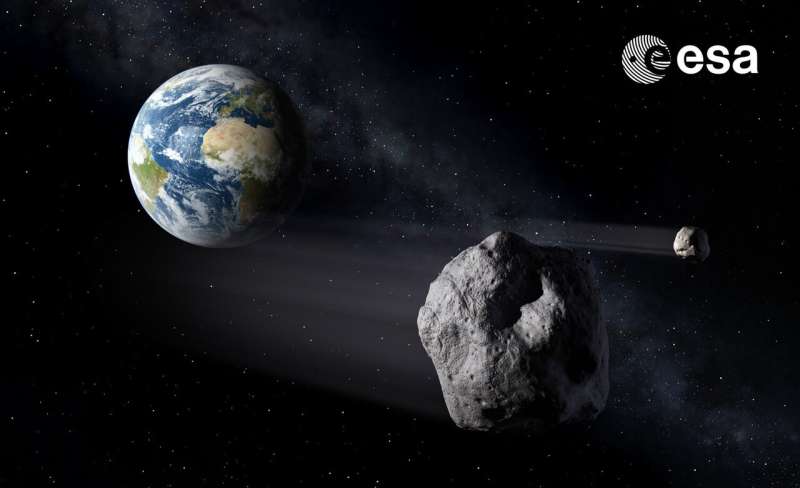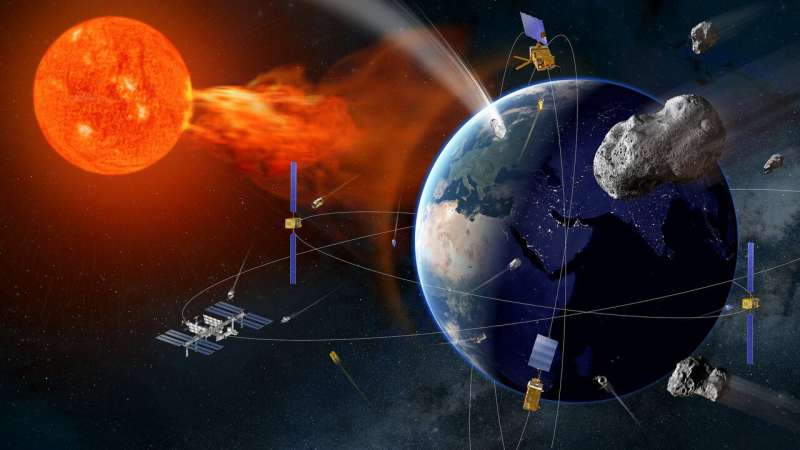Asteroids passing Earth. Credit: European Space Agency
The United Nations' International Asteroid Day on 30 June highlights ESA's expanding efforts to secure our future by understanding and addressing risks posed by near-Earth objects that could impact our planet.
"The work of ESA and the international planetary defence community is a great example of how to address this important hazard," says ESA Director General Jan Wörner. "An asteroid impact is the only natural disaster we might avoid, if we see one coming soon enough."
"Even when the threat is low, governments and international organisations such as the UN working together show that it is possible to get ready in advance and mitigate damage from a global threat that can affect anyone, anywhere."
Current ESA activities include:
- Detailed design work is proceeding on ESA's first planetary defence validation mission: the Hera spacecraft will fly to the Didymos asteroid pair in 2024, following on from NASA's DART mission due to be launched next year, which will deflect the smaller asteroid.
- ESA's long-running asteroid observations have resumed, following a brief pause due to the COVID-19 pandemic. Near-Earth asteroids are identified and tracked from various telescopes across Europe and the world.
- ESA's Near-Earth Object (NEO) Coordination Centre in Italy continues to coordinate asteroid observations and assess risks from newly discovered objects, despite the serious COVID-19 effects in that country.
- The first of ESA's new multi-optic 'Flyeye' telescopes is under construction near Milan, and will facilitate the automated detection of asteroids once in operation.
- ESA's deep-space ground stations have contributed communication coverage for Japan's Hayabusa2 mission, which is now headed Earthward after collecting samples from an asteroid.
- ESA is sponsoring a Grand Challenge on In-Situ Resource Utilisation for the Moon and asteroids, allowing future explorers to make use of materials found in space. Temporarily suspended due to the COVID-19 pandemic, this €500 000 competition is set to resume soon.
- The Agency's suitcase-sized 'Miniature Asteroid Remote Geophysical Observer' (M-Argo) spacecraft is about to undergo its Preliminary Requirements Review, where experts will declare this audacious mission feasible.ESA's Comet Interceptor mission, planned to launch near the end of this decade, will wait in space for a suitable body—potentially even an interstellar comet—to investigate.
ESA and Space Safety
Under the Agency's Space Safety Programme, which received an important boost in funding at the Space19+ Ministerial Council in November 2019, ESA is taking action as part of an international effort to mitigate asteroid risks.
ESA's goal is to coordinate Europe's part of a global planetary defence effort, aimed at detecting, studying and following asteroids, predicting if and when they might hit and taking mitigation action if needed.
Space Safety & Security. Credit: European Space Agency
UN Asteroid Day
On 30 June 1908, the Tunguska impact felled many millions of trees across 2200 sq km of Siberian territory, only a few hours of Earth rotation away from Europe—the results would have been disastrous over a populated area.
Asteroid Day, a UN-endorsed awareness campaign day to mark this historic date, was co-founded by astrophysicist and famed musician Dr. Brian May of the rock group Queen, Apollo 9 astronaut Rusty Schweickart, filmmaker Grig Richters, and B612 President Danica Remy.
Asteroid Day TV supported by ESA
This year, activities to mark Asteroid Day are moving entirely online, and include a month of Asteroid Day TV distributed by the Luxembourg-based Asteroid Foundation and including programming by ESA as well as top content makers including Discovery Science, TED, IMAX, BBC, CNN, ESO and other educational producers.
Asteroid Day TV will distribute Asteroid Day LIVE from Luxembourg starting 30 June at 12:00 CEST including five hours of ESA and Asteroid Day programme segments newly produced for 2020 in English.
ESA is also planning new programme segments in Dutch, French, German, Italian and Spanish. These will premiere in advance of 30 June.
All segments will be broad- and webcast to the public via AsteroidDay.org, via SES Satellite and to other broadcasters via satellite and digital CDN via RTL's Broadcasting Center Europe (BCE).
Provided by European Space Agency
























